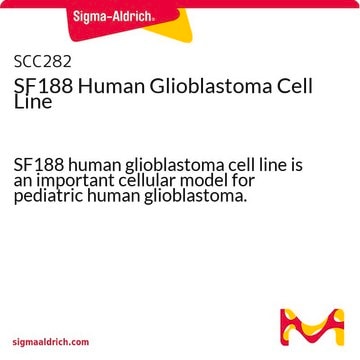T98G Cell Line human
92090213, human brain, Not specified
Synonym(s):
T 98 G Cells, T-98G Cells, T98-G Cells
Sign Into View Organizational & Contract Pricing
All Photos(1)
About This Item
UNSPSC Code:
41106514
Recommended Products
product name
T98G Cell Line human, 92090213
biological source
human brain
description
Human Caucasian glioblastoma
growth mode
Adherent
karyotype
Hyperpentaploid, modal no. 128-132
morphology
Not specified
products
Not specified
receptors
Not specified
technique(s)
cell culture | mammalian: suitable
relevant disease(s)
cancer
shipped in
dry ice
storage temp.
−196°C
Related Categories
Cell Line Origin
Human Caucasian glioblastoma
Cell Line Description
Derived from glioblastoma multiform tumour from a 61-year-old Caucasian male. Indefinite lifespan and anchorage independent but can enter viable G1 arrested state when deprived of serum.
Application
Studies on the mechanism for cessation of proliferation in quiescent cells and cells synchronised in G1 phase.
T98G has been used to study the effects of the lysosomal destabilizing drug Siramesine on glioblastoma. It has also been used to study the efficiency of empty spiracles homeobox 2 (EMX2) in suppressing glioblastoma.
DNA Profile
STR-PCR Data: Amelogenin: X,Y
CSF1PO: 10,12
D13S317: 13
D16S539: 13
D5S818: 10,12
D7S820: 9,10
THO1: 7,9.3
TPOX: 8
vWA: 17,20
CSF1PO: 10,12
D13S317: 13
D16S539: 13
D5S818: 10,12
D7S820: 9,10
THO1: 7,9.3
TPOX: 8
vWA: 17,20
Culture Medium
EMEM (EBSS) + 2mM Glutamine + 1% Non Essential Amino Acids (NEAA) + 1% Sodium Pyruvate (NaP) + 10% Foetal Bovine Serum (FBS).
Subculture Routine
Split sub-confluent cultures (70-80%) 1:3 to 1:6 i.e. seeding at 2-4x10,000 cells/cm2 using 0.25% trypsin/EDTA; 5% CO2; 37°C. Cells may become anchorage-independent if deprived of serum.
Other Notes
Additional freight & handling charges may be applicable for Asia-Pacific shipments. Please check with your local Customer Service representative for more information.
Certificates of Analysis (COA)
Search for Certificates of Analysis (COA) by entering the products Lot/Batch Number. Lot and Batch Numbers can be found on a product’s label following the words ‘Lot’ or ‘Batch’.
Already Own This Product?
Find documentation for the products that you have recently purchased in the Document Library.
Our team of scientists has experience in all areas of research including Life Science, Material Science, Chemical Synthesis, Chromatography, Analytical and many others.
Contact Technical Service





